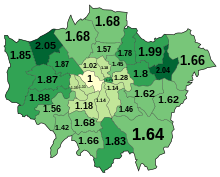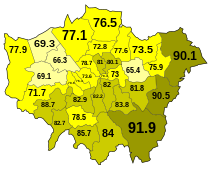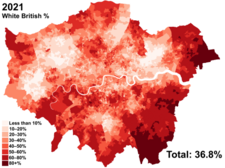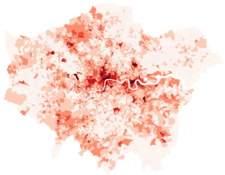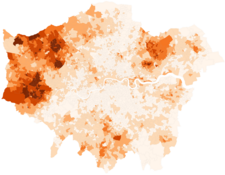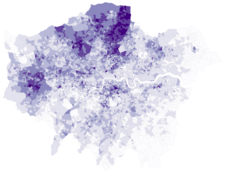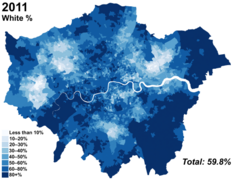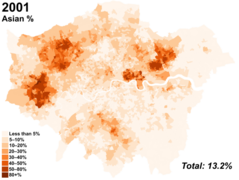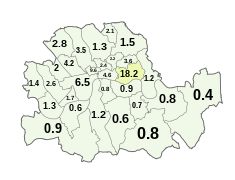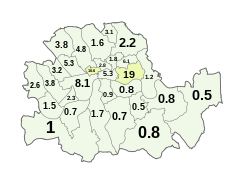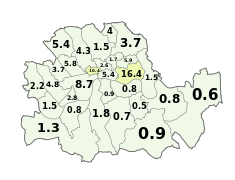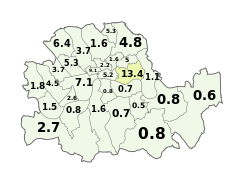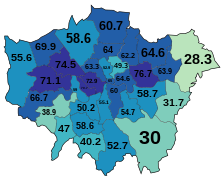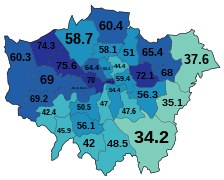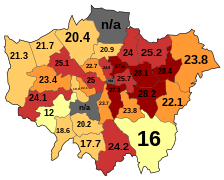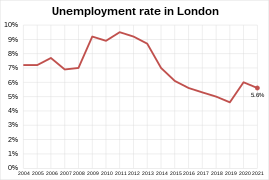Demographics of London Population Density 2 (15,160/sq mi) (2020 estimates)[ 1] Growth rate [ 2] Life expectancy • male [ 3] • female Fertility rate [ 4] Infant mortality rate [ 5] Nationality British Major ethnic White : 53.8% (2021)
White British : 36.8% (2021)Minor ethnic
Asian British : 20.8% (2021)Black British : 13.5% (2021) Spoken British English (main language: 78.4%)
The demography of London is analysed by the Office for National Statistics and data is produced for each of the Greater London wards , the City of London and the 32 London boroughs , the Inner London and Outer London statistical sub-regions, each of the Parliamentary constituencies in London , and for all of Greater London as a whole. Additionally, data is produced for the Greater London Urban Area . Statistical information is produced about the size and geographical breakdown of the population, the number of people entering and leaving country and the number of people in each demographic subgroup. The total population of London as of 2021 is 8,799,800.[ 6]
History
Creation of Greater London - 1965
Through the London Government Act of 1963 , the Greater London region was established officially in 1965.[ 7]
Migration boom - 1991 to today
From 1997 onwards, London has experienced a drastic change in the composition of the city's population, which has off set the decline of the population which had been occurring [citation needed . In 1991, 21.7% of the city was foreign born but by 2011 this had risen to 36.7%.
In 2011, a historic tipping point occurred with the release of the 2011 census indicating that the White British population, which had before been the majority, was now no longer a majority of the city's population, although it remained by far the largest single ethnic group.[ 8]
Population
Population growth percentage in London between 2011 and 2021 Historical population Year 1801 1,011,157 — 1811 1,197,673 +18.4% 1821 1,450,122 +21.1% 1831 1,729,949 +19.3% 1841 1,917,013 +10.8% 1851 2,286,609 +19.3% 1861 3,094,391 +35.3% 1871 3,902,178 +26.1% 1881 4,709,960 +20.7% 1891 5,565,856 +18.2% 1901 6,226,494 +11.9% 1911 7,157,875 +15.0% 1921 7,553,526 +5.5% 1931 8,098,942 +7.2% 1941 7,987,936 −1.4% 1951 8,164,416 +2.2% 1961 7,781,342 −4.7% 1971 7,449,184 −4.3% 1981 6,608,513 −11.3% 1991 6,887,280 +4.2% 2001 7,172,036 +4.1% 2011 8,173,941 +14.0% 2021 8,799,800 +7.7%
The historical population for the current area of Greater London, divided into the statistical areas of Inner and Outer London is as follows:
(click "show" to expand)
London population over time[ 9] [ 10] [ 11]
Year
Inner London
Outer London
Greater London
1801
879,491
131,666
1,011,157
1811
1821
1831
1841
1851
1861
1871
1881
1891
1901
1911
1921
1931
1941
1951
1961
1971
1981
1991
2001
2011[ 12]
2021
Age
London population pyramid from 1991 to 2021
Population pyramid of each borough in London
Barking and Dagenham
Bexley
Brent
Bromley
Camden
City of London
Croydon
Ealing
Enfield
Hackney
Greenwich
Harrow
Hammersmith and Fulham
Haringey
Hillingdon
Havering
Hounslow
Islington
Kensington and Chelsea
Kingston upon Thames
Lambeth
Lewisham
Merton
Newham
Redbridge
Richmond upon Thames
Southwark
Sutton
Waltham Forest
Tower Hamlets
Wandsworth
Westminster
Percentage of the population in age groups
Under 15s in London
15 to 64 year olds
Over 64 years old
Fertility
Fertility rate of each London borough in 2021
In 2021, a total of 110,961 live births occurred within the city.[ 13] [ 4]
Population density
Population density in the 2011 census in Greater London. The population density of London was 5,727 per km2 in 2011.[ 14]
Urban and metropolitan area
At the 2001 census, the population of the Greater London Urban Area was 8,278,251.[ 15] South East England and East of England regions. In 2004 the London Plan of the Mayor of London defined a metropolitan region with a population of 18 million.[ 16] Larger Urban Zone is 11,917,000; it occupies an area of 8,920 square kilometres (3,440 sq mi). Another definition gives the population of the metropolitan area as 13,709,000.[ 17]
Ethnicity
For the overwhelming majority of London's history, the population of the city was ethnically homogenous with the population being of White British ethnic origin,[ 18] East End . From 1948 onwards and especially since the 1990s, the population has diversified in international terms at an increased rate.[ 18] [ 8] [ 19]
Ethnicity overall
London ethnic demographics over time Ethnic makeup of London in single year age groups in 2021 Ethnic makeup of London over time in age groups The following table shows the ethnic group of respondents from estimates in 1971 and in the 1991 – 2021 censuses in Greater London.
Ethnic make-up of Greater London
Ethnic Group
Year
1961 estimations[ 20] [ 21]
1966 estimations[ 22]
1971 estimations[ 18] [ 23]
1981 estimations[ 24]
1991 census[ 25] [ 26]
2001 census[ 27]
2011 census[ 28]
2021 census[ 29]
Number
%
Number
%
Number
%
Number
%
Number
%
Number
%
Number
%
Number
%
White : Total
7,602,233
97.7%
–
95.9%
6,901,596
92.6%
5,893,973
86.6%
5,333,580
79.80%
5,103,203
71.15%
4,887,435
59.79%
4,731,172
53.8%
White: British [ Note 1]
–
–
–
–
6,500,000
87%
–
–
–
–
4,287,861
59.79%
3,669,284
44.89%
3,239,281
36.8%
White: Irish
–
–
–
3.6%
401,596
5.4%
–
–
256,470
3.83%
220,488
3.07%
175,974
2.15%
156,333
1.8%
White: Gypsy or Irish Traveller [ Note 2]
–
–
–
–
–
–
–
–
–
–
8,196
0.10%
7,031
0.1%
White: Roma
–
–
–
–
–
–
–
–
–
–
–
–
37,689
0.4%
White: Other [ Note 1]
–
–
–
–
–
–
–
–
594,854
8.29%
1,033,981
12.65%
1,290,838
14.7%
Asian or Asian British : Total
–
–
–
1.5%
–
–
425,426
6.3%
690,031
10.33%
946,894
13.20%
1,511,546
18.49%
1,817,640
20.8%
Asian or Asian British: Indian
–
–
–
–
–
–
232,881
3.4%
347,091
5.19%
436,993
6.09%
542,857
6.64%
656,272
7.5%
Asian or Asian British: Pakistani
–
–
–
–
–
–
59,440
0.9%
87,816
1.31%
142,749
1.99%
223,797
2.74%
290,549
3.3%
Asian or Asian British: Bangladeshi
–
–
–
–
–
–
41,792
0.6%
85,738
1.28%
153,893
2.15%
222,127
2.72%
322,054
3.7%
Asian or Asian British: Chinese [ Note 3]
–
–
–
–
–
–
35,938
0.5%
56,579
0.84%
80,201
1.12%
124,250
1.52%
147,520
1.7%
Asian or Asian British: Other Asian
–
–
–
–
–
–
55,375
0.8%
112,807
1.68%
133,058
1.86%
398,515
4.88%
401,245
4.6%
Black or Black British : Total
–
–
–
2.6%
–
–
405,394
6%
535,216
8.01%
782,849
10.92%
1,088,640
13.32%
1,188,370
13.5%
Black or Black British: African
–
–
–
0.6%
–
–
102,230
1.5%
163,635
2.44%
378,933
5.28%
573,931
7.02%
697,054
7.9%
Black or Black British: Caribbean
–
–
–
2%
–
–
239,956
3.5%
290,968
4.35%
343,567
4.79%
344,597
4.22%
345,405
3.9%
Black or Black British: Other Black
–
–
–
–
–
–
63,208
0.9%
80,613
1.20%
60,349
0.84%
170,112
2.08%
145,911
1.7%
Mixed or British Mixed : Total[ Note 1] –
–
–
–
–
–
–
–
–
–
226,111
3.15%
405,279
4.96%
505,775
5.7%
Mixed: White and Black Caribbean
–
–
–
–
–
–
–
–
–
–
70,928
0.99%
119,425
1.46%
132,555
1.5%
Mixed: White and Black African
–
–
–
–
–
–
–
–
–
–
34,182
0.48%
65,479
0.80%
77,341
0.9%
Mixed: White and Asian
–
–
–
–
–
–
–
–
–
–
59,944
0.84%
101,500
1.24%
125,188
1.4%
Mixed: Other Mixed
–
–
–
–
–
–
–
–
–
–
61,057
0.85%
118,875
1.45%
170,691
1.9%
Other: Total
–
–
–
–
–
–
80,793
1.2%
120,872
1.81%
113,034
1.58%
281,041
3.44%
556,768
6.3%
Other: Arab[ Note 2]
–
–
–
–
–
–
–
–
–
–
–
–
106,020
1.30%
139,791
1.6%
Other: Any other ethnic group
–
–
–
–
–
–
–
–
–
–
113,034
1.58%
175,021
2.14%
416,977
4.7%
Non-White: Total
179,109
2.3%
–
4.1%
547,588
7.4%
911,626
13.4%
1,346,119
20.2%
2,068,888
28.85%
3,286,506
40.2%
4,068,553
46.2%
Total
7,781,342
100%
–
100%
7,449,184
100%
6,805,599
100%
6,679,699
100.00%
7,172,091
100.00%
8,173,941
100.00%
8,799,725
100%
^ a b c New category created for the 2001 census
^ a b New category created for the 2011 census
^ In 2001, listed under the 'Other ethnic group' heading.
Distribution of ethnic groups in Greater London in the 2021 census
Population pyramid of London by ethnicity in 2021 Ethnicity of school pupils
(click "show" to expand)
Ethnicity of school pupils within London
Ethnic group
School year[ 30] [ 31]
1999[ 32]
2004
2008
2012
2015/16
2017/18
2019/20
2021/2022
Number
%
Number
%
Number
%
Number
%
Number
%
Number
%
Number
%
Number
%
White : Total
521,332
59%
467,230
51.4%
431,040
46.7%
416,490
42.8%
443,621
41.1%
522,187
40.4%
520,767
39.8%
506,271
38.7%
White: British
–
–
389,350
42.9%
339,610
36.8%
305,805
31.4%
295,572
27.4%
333,497
25.8%
324,358
24.8%
312,522
23.9%
White: Irish
–
–
10,610
1.2%
8,610
0.9%
7,610
0.8%
6,939
0.6%
7,322
0.6%
6,759
0.5%
6,268
0.5%
White: Traveller of Irish heritage
–
–
1,090
0.1%
920
0.1!
1,000
0.1%
1,031
0.1%
1,183
0.1%
1,205
0.1%
1,182
0.1%
White: Gypsy/Roma
–
–
780
0.09%%
950
0.1%
1,505
0.2%
1,643
0.2%
2,074
0.2%
2,359
0.2%
2,358
0.2%
White: Other
–
–
65,410
7.2%
80,950
8.8%
100,570
10.3%
138,436
12.8%
178,111
13.8%
186,086
14.2%
183,941
14.0%
Asian / Asian British : Total
134,872
15.3%
159,370
17.5%
174,380
18.9%
198,280
20.4%
228,767
21.2%
283,443
22%
296,324
22.6%
305,069
23.2%
Asian / Asian British: Indian
65,151
57,990
6.4%
54,570
5.9%
54,490
5.6%
62,065
5.7%
78,700
6.1%
85,521
6.5%
89,639
6.8%
Asian / Asian British: Pakistani
28,215
31,220
3.4%
34,680
3.8%
41,235
4.2%
47,931
4.4%
59,047
4.6%
60,415
4.6%
60,707
4.6%
Asian / Asian British: Bangladeshi
33,846
38,880
4.2%
44,100
4.8%
51,300
5.3%
59,691
5.5%
73,994
5.7%
77,408
5.9%
79,954
6.1%
Asian / Asian British: Chinese
7,660
7,220
0.8%
6,970
0.8%
6,920
0.7%
7,883
0.7%
10,116
0.8%
10,475
0.8%
12,267
0.9%
Asian / Asian British: Other Asians
–
24,060
2.6%
34,060
3.7%
44,335
4.6%
51,197
4.7%
61,586
4.8%
62,505
4.8%
62,502
4.8%
Black / Black British : Total
148,040
16.7%
170,780
18.8%
188,750
20.5%
208,375
21.4%
226,215
20.9%
254,081
19.7%
244,988
18.7%
234,822
17.9%
Black: Caribbean
57,956
63,020
6.9%
59,750
6.5%
57,980
5.9%
55,414
5.1%
57,862
4.5%
53,733
4.1%
50,178
3.8%
Black: African
61,983
91,020
10%
110,090
11.92%
128,295
13.1%
145,447
13.5%
167,058
12.9%
162,680
12.4%
156,883
12.0%
Black: Other Blacks
28,101
16,740
1.8%
18,930
2.1%
22,100
2.3%
25,354
2.3%
29,161
2.3%
28,575
2.2%
27,761
2.1%
Mixed / British Mixed
–
57,720
6.4%
70,330
7.6%
84,615
8.7%
104,470
9.7%
134,226
10.4%
142,135
10.8%
150,285
11.3%
Other: Total
62,014
7%
34,750
3.8%
44,290
4.8%
52,640
5.4%
60,865
5.6%
74,589
5.7%
77,413
5.9%
82,516
6.3%
Unclassified
17,909
2%
18,760
2.1%
6,750
0.7%
13,470
1.4%
16,194
1.5%
22,232
1.7%
27,935
2.1%
30,359
2.3%
Total:
884,167
100%
908,600
100%
922,890
100%
973,875
100%
1,080,132
100%
1,290,758
100%
1,309,562
100%
1,309,322
100%
School pupils as a percentage of the school population in each borough in 2021/2022 school year
White: Total
Ethnicity of births
Ethnic Group
Year[ 33]
1981 estimates[ 34]
2007
2010
2015
2019
2021[ 35]
Number
%
Number
%
Number
%
Number
%
Number
%
Number
%
White : Total
–
80%
58,024
46.4%
65,117
49.5%
61,716
47.8%
57,405
48.7%
53,141
48%
White: British
–
–
–
–
–
–
–
–
–
–
25,827
23.3%
White: Other
–
–
–
–
–
–
–
–
–
–
27,314
24.7%
Asian / Asian British : Total
–
–
21,701
17.3%
24,445
18.5%
26,957
20.9%
24,616
20.9%
24,426
22.1%
Asian / Asian British: Indian
–
–
–
–
–
–
–
–
–
–
8,259
7.5%
Asian / Asian British: Pakistani
–
–
–
–
–
–
–
–
–
–
4,341
3.9%
Asian / Asian British: Bangladeshi
–
–
–
–
–
–
–
–
–
–
5,458
4.9%
Asian / Asian British: Other Asians
–
–
–
–
–
–
–
–
–
–
6,368
5.8%
Black / Black British : Total
–
–
22,036
17.6%
22,293
16.9%
18,526
14.3%
15,319
13%
13,476
12.2%
Black: Caribbean
–
–
–
–
–
–
–
–
–
–
2,893
2.6%
Black: African
–
–
–
–
–
–
–
–
–
–
8,697
7.9%
Black: Other Blacks
–
–
–
–
–
–
–
–
–
–
1,886
1.7%
Mixed / British Mixed
–
–
7,967
6.3%
9,424
7.1%
11,979
9.3%
12,041
10.2%
12,502
11.3%
Other: Total
–
–
6,337
5%
5,831
4.4%
6,770
5.2%
6,494
5.5%
5,367
4.8%
Not Stated
–
–
9,055
7.2%
4,391
3.3%
3,170
2.4%
1,880
1.5%
1,787
1.6%
Non-White: Total (not including Not stated)
–
20%
58,041
46.2%
61,993
46.9%
64,232
49.7%
58,470
49.6%
55,771
50.4%
Total:
–
100%
125,120
100%
131,501
100%
129,118
100%
117,755
100%
110,699
100%
Ethnicity in boroughs
This table shows the proportion of different multi-ethnic groups by London borough, as found in the 2021 census .
(click "show" to expand)
Broad multi-ethnic group make-up of London boroughs (2021)
Local authority
White
Mixed
Asian
Black
Other
Barnet
57.7
5.4
19.3
7.9
9.8
Barking and Dagenham
44.9
4.3
25.9
21.4
3.6
Bexley
71.9
3.5
9.9
12.2
2.5
Brent
34.6
5.1
32.8
17.5
10
Bromley
76.5
5.4
8.3
7.6
2.3
Camden
59.5
6.6
18.1
9.0
6.8
City of London
69.4
5.5
16.8
2.7
5.6
Croydon
48.4
7.6
17.5
22.6
3.9
Ealing
43.2
5.2
30.3
10.8
10.6
Enfield
52.1
5.9
11.5
18.3
12.1
Greenwich
55.7
6.0
13.2
21
4.2
Hackney
53.1
6.7
10.4
21.1
8.7
Haringey
57
7
8.7
17.6
9.7
Harrow
36.5
3.8
45.2
7.3
7.2
Havering
75.3
3.7
10.7
8.2
2
Hammersmith and Fulham
63.2
6.7
10.5
12.3
7.3
Hillingdon
48.2
4.4
33.3
7.8
6.3
Hounslow
44.1
4.7
36.7
7.2
7.3
Islington
62.2
7.5
9.9
13.3
7.1
Kensington and Chelsea
63.7
6.6
11.9
7.9
9.9
Kingston upon Thames
68.3
5.4
17.8
2.8
5.7
Lambeth
55
8.1
7.3
24
5.7
Lewisham
51.5
8.1
9
26.8
4.7
Merton
60.2
5.9
18.6
10.6
4.6
Newham
30.8
4.7
42.2
17.5
4.9
Redbridge
34.8
4.1
47.3
8.4
5.4
Richmond upon Thames
80.5
5.5
8.9
1.9
3.3
Southwark
51.4
7.2
9.9
25.1
6.3
Sutton
68.3
4.8
17.5
5.9
3.4
Tower Hamlets
39.4
5
44.4
7.3
3.9
Waltham Forest
52.8
6.5
19.9
15
5.8
Wandsworth
67.8
6.3
11.7
10.1
4.1
Westminster
55.2
6.5
16.8
8.1
13.5
White multi-ethnic group over time
1991 (79.8%)
2001 (71.2%)
2011 (59.8%)
2021 (53.8%)
Asian multi-ethnic group over time
1991 (10.3%)
2001 (13.2%)
2011 (18.5%)
2021 (20.8%)
Black multi-ethnic group over time
1991 (8%)
2001 (10.9%)
2011 (13.3%)
2021 (13.5%)
Country of birth
Foreign born within London over time from 1851 to 2021 Foreign born in London by age over time UK born and foreign born population pyramid in London in 2021. Males and females representing the UK born population whileforeign males and females representing the foreign born population. Foreign born and UK born percentage of age groups in London The 2021 census recorded that 3,575,740 people or 40.7% of London's population are foreign-born (including 27.9% born in a non-European country).[ 36]
(click "show" to expand)
Country of Birth
Year
1951 (County of London )[ 37]
1971 census[ 38] [ 39]
1981 census[ 40] [ 41]
1991 census[ 42]
2001 census[ 43]
2011 census[ 44]
2021 census[ 36]
Number
%
Number
%
Number
%
Number
%
Number
%
Number
%
Number
%
Europe
3,239,240
96.8%
6,568,348
90.76%
5,787,624
87.57%
5,639,192
84.4%
5,741,636
80%
6,174,371
75.5%
6,346,649
72.1%
United Kingdom
3,018,418
90.2%
6,133,105
84.74%
5,405,576
81.79%
5,228,658
78.3%
5,231,701
72.9%
5,175,677
63.3%
5,223,986
59.3%
England
2,871,072
85.8%
5,175,884
78.3%
5,001,658
74.9%
5,010,969
69.9%
4,997,072
61.1%
5,075,165
57.7%
Scotland
62,980
109,935
1.7%
113,117
1.7%
108,682
1.5%
89,527
1.1%
75,004
0.9%
Wales
59,416
79,000
1.2%
70,532
1.1%
71,962
1.0%
53,828
0.7%
44,806
0.5%
Northern Ireland
42,243
0.6%
37,574
0.5%
32,774
0.4%
28,248
0.3%
Ireland
89,895
236,396
3.26%
199,460
3.01%
214,033
3.2%
157,556
2.2%
129,807
1.6%
96,566
1.1%
European Community or Other Europe
130,927
3.9%
198,847
2.74%
182,588
2.76%
196,501
352,379
865,681
1,122,663
12.8%
Germany
18,024
32,027
0.5%
39,818
0.6%
55,476
0.7%
50,364
0.6%
France
8,081
20,923
0.3%
38,130
0.5%
66,654
0.8%
77,715
0.9%
Italy
9,603
30,052
0.4%
38,694
0.5%
62,050
0.8%
126,059
1.4%
Spain
19,047
0.3%
22,480
0.3%
35,880
0.4%
68,114
0.8%
Poland
32,787
21,823
0.3%
22,224
0.3%
158,300
1.9%
149,397
1.7%
Romania
1,737
1,774
0.0%
3,049
0.0%
44,848
0.5%
175,991
2.0%
Cyprus
6,799
50,684
0.8%
45,888
0.6%
35,300
0.4%
Russia
16,046
5,234
0.1%
10,361
0.1%
16,757
0.2%
25,770
0.3%
Turkey
1,080
20,426
0.3%
39,128
0.5%
59,596
0.7%
72,867
0.8%
Asia
20,999
0.6%
161,777
2.23%
234,599
3.54%
435,819
6.5%
634,917
8.9%
966,990
11.8%
1,146,247
13%
India
16,370
104,001
1.43%
139,123
2.10%
151,619
2.3%
172,661
2.4%
262,247
3.2%
322,644
3.7%
Pakistan
1,578
29,395
0.40%
35,625
0.53%
44,741
0.7%
66,658
0.9%
112,457
1.4%
129,774
1.5%
Bangladesh
22,108
0.33%
56,657
0.8%
84,565
1.2%
109,948
1.3%
138,895
1.6%
Sri Lanka
25,818
0.4%
49,932
0.7%
84,542
1.0%
80,379
0.9%
China
1,350
6,996
0.1%
13,776
0.2%
39,452
0.5%
56,116
0.6%
Hong Kong
586
18,398
0.3%
23,328
0.3%
26,435
0.3%
33,760
0.4%
Other Asia
–
–
28,381
0.39%
37,741
0.57%
–
–
–
–
–
–
–
–
Old Commonwealth
14,233
0.4%
38,738
0.53%
37,064
0.56%
53,320
0.8%
84,264
–
–
84,248
Australia
6,536
23,315
0.3%
41,488
0.6%
53,959
0.7%
43,418
0.5%
Canada
5,339
11,626
0.2%
15,282
0.2%
21,288
0.3%
21,772
0.2%
New Zealand
2,358
18,379
0.3%
27,494
0.4%
28,547
0.3%
19,058
0.2%
Africa
10,783
0.3%
74,660
1.03%
144,072
2.18%
246,025
454,536
621,613
625,071
7.1%
South Africa
4,668
6,471
0.1%
45,507
0.6%
57,765
0.7%
47,964
0.5%
Nigeria
1,261
36,047
0.5%
68,907
1.0%
114,718
1.4%
117,145
1.3%
Kenya
314
56,993
0.9%
66,311
0.9%
64,212
0.8%
58,020
0.7%
Ghana
26,925
0.4%
62,896
0.8%
65,905
0.7%
Somalia
50
33,831
0.5%
65,333
0.8%
66,288
0.8%
America/Caribbean (NCWP for 1971)
12,241
0.4%
165,369
2.28%
167,399
2.53%
249,191
326,280
367,664
4.2%
Jamaica
2,139
76,445
1.1%
80,319
1.1%
87,467
1.1%
52,613
0.6%
United States
5,942
32,667
0.5%
44,622
0.6%
63,920
0.8%
71,127
0.8%
Brazil
357
–
31,357
0.4%
55,787
0.6%
Antarctica and Oceania (including Australasia) and Other
–
–
–
–
–
–
–
–
70,632
84,661
64,228
0.7%
British Overseas
–
–
–
–
–
–
–
–
–
–
–
–
5,994
–
Other: Total
–
–
227,829
3.14%
237,840
3.59%
1,118
21,179
26
–
–
Foreign born: Total
224,801
9.8%
1,103,616
1,451,041
21.7%
1,940,390
27.1%
2,998,264
36.7%
3,575,740
40.7%
Total
3,347,982
100%
7,236,721
100.00%
6,608,598
100.00%
6,679,699
100%
7,172,091
100%
8,173,941
100%
8,799,726
100%
NOTE: The sub-categories included for each continent may not add up to their respective total amount because the sub categories are only supposed to show the most numerous country of birth from said area.
Foreign born in the County of London (excluding Irish born in images)
1901 (5% overall including Irish born)
1911 (5% overall including Irish born)
1921 (4% overall including Irish born)
1931 (5% overall including Irish born)
1951 (8% overall including Irish born)
Foreign born in London over time
1961 (9.8%)
1971 (15.3%)
1981 (18.2%)
1991 (21.7%)
2001 (27.1%)
2011 (36.7%)
2021 (40.7%)
Region of birth of mother[ 45]
2001
2006
2011
2016
2021
Number
%
Number
%
Number
%
Number
%
Number
%
United Kingdom
59,104
56.7%
57,376
47.5%
57,450
43.2%
53,866
41.8%
47,958
43.2%
Foreign born
45,058
43.3%
63,522
52.5%
75,383
56.7%
74,923
58.2%
62,986
56.8%
EU
6,977
6.7%
11,309
9.4%
18,402
13.8%
22,573
17.5%
18,365
16.5%
Rest of Europe
3,380
3.2%
4,090
3.4%
4,160
3.1%
5,382
4.2%
5,933
5.3%
Middle East and Asia
13,489
13%
18,206
15%
25,478
19.2%
24,235
18.8%
21,394
19.2%
Africa
13,600
13.1%
20,043
16.6%
19,866
15%
15,600
12.1%
10,725
9.7%
Rest of the world
7,612
7.3%
9,874
8.2%
7,477
5.6%
7,133
5.5%
6,569
5.9%
Total
104,162
1000%
120,898
100%
132,843
100%
128,803
100%
110,961
100%
Born to foreign born mothers
2007
2014
2021
Population pyramids of country of birth groupings in 2021
UK born
Foreign born: Total
Languages
Percentage of the population whose main language is English in London in 2021 According to the 2011 Census , 6,083,420 or 77.9% of London's population aged 3 and over spoke English as a main language, with a further 1,406,912 (19.8%) speaking it as a second language or well to very well.[ 46] [ 46] Welsh and 2,926 (<0.1%) used British Sign Language .[ 47] Polish , etc.
The most common main languages spoken in Greater London according to the 2011 and 2021 censuses are shown below.[ 48]
Main language
Proficiency in English
Language proficiency
London (aged 3 and over)
2011[ 49]
2021[ 50]
Number
%
Number
%
Main language is English
6,083,420
77.9%
6,650,973
78.4%
Main language is not English
1,726,522
22.1%
1,831,690
21.6%
Can speak English very well
763,502
9.8%
840,463
9.9%
Can speak English well
643,410
8.2%
636,226
7.5%
Cannot speak English well
271,693
3.5%
303,265
3.6%
Cannot speak English
47,917
0.6%
51,736
0.6%
Total
7,809,942
100%
8,482,663
100%
Religion
Religious makeup of London in single year age groups in 2021 London's religious landscape over the past two decades has undergone significant change. In 2001, Christians constituted the majority at 58.23%, but by 2021, this percentage had declined to 40.66%. Meanwhile, the population identifying with no religion saw a significant increase, rising from 15.76% in 2001 to 27.05% in 2021. This shift suggests a growing trend of secularization in the city.[citation needed
The Muslim population also experienced notable growth, increasing from 8.46% in 2001 to 14.99% in 2021. The number of individuals who chose not to state their religion slightly fluctuated during these years, from 8.66% in 2001 to 7.00% in 2021.
Hinduism saw steady growth, constituting 4.07% of the population in 2001 and rising to 5.15% in 2021. The Jewish community remained relatively stable but saw a slight decline from 2.09% to 1.65% over the same period. Sikhism also experienced growth, albeit modest, from 1.45% in 2001 to 1.64% in 2021. Other religions, including Buddhism, collectively accounted for small but fluctuating percentages, with Buddhism specifically ranging from 0.76% in 2001 to 0.88% in 2021.
These changes are influenced by various factors, including immigration, generational attitudes, and broader social trends.[citation needed
Distribution of religions in Greater London according to the 2011 census.
Christianity
Islam
Hinduism
Judaism
Sikhism
Buddhism
Other religion
No religion
Population pyramid of London by religion in 2021
Population pyramids of each religious group in London
Christian
No religion
None stated
Muslim
Hindu
Buddhist
Sikh
Jewish
Other religion
Ethnicity by religion
Ethnic Group
2021 census[ 55]
Christian
Muslim
Hindu
Other
No religion
Undeclared
Number
Number
Number
Number
Number
Number
White : Total
2,271,066
113,038
1,450
164,195
1,837,754
343,671
White: British
1,426,511
37,544
841
112,911
1,446,794
214,682
White: Irish
109,149
604
60
1,720
35,793
9,007
White: Gypsy or Irish Traveller
4,852
141
16
130
1,445
447
White: Roma
25,646
890
20
455
7,680
2,998
White: Other
704,908
73,859
513
48,979
346,042
116,537
Asian or Asian British : Total
205,801
716,586
421,063
197,465
175,004
101,716
Asian or Asian British: Indian
75,625
66,763
329,329
122,742
31,289
30,524
Asian or Asian British: Pakistani
3,601
264,201
548
582
5,195
16,421
Asian or Asian British: Bangladeshi
1,057
295,963
3,570
442
4,175
16,843
Asian or Asian British: Chinese
26,018
603
162
16,722
89,546
14,469
Asian or Asian British: Other Asian
99,500
89,056
87,454
56,977
44,799
23,459
Black or Black British : Total
775,655
216,758
976
9,382
103,015
82,586
Black or Black British: African
434,796
196,647
375
2,965
25,603
36,667
Black or Black British: Caribbean
241,736
3,875
399
4,851
60,825
33,719
Black or Black British: Other Black
99,123
16,236
202
1,566
16,587
12,200
Mixed or British Mixed : Total
197,939
47,532
3,943
14,004
194,909
47,449
Mixed: White and Black Caribbean
57,671
1,964
75
1,809
59,103
11,933
Mixed: White and Black African
39,137
9,631
98
975
21,121
6,380
Mixed: White and Asian
36,027
12,648
2,648
5,118
56,599
12,148
Mixed: Other Mixed
65,104
23,289
1,122
6,102
58,086
16,988
Other: Total
127,219
224,840
25,602
69,143
69,722
40,241
Other: Arab[ Note 1]
6,420
113,809
61
1,174
7,394
10,932
Other: Any other ethnic group
120,799
111,031
25,541
67,969
62,328
29,309
Total
3,577,681
1,318,754
453,034
454,193
2,380,404
615,662
^ New category created for the 2011 census
Social issues
Marriage and divorce
In 2019, a total of 29,139 marriages occurred within London.[ 56]
Abortion
In 2020, 27.7% of conceptions were aborted in the city.[ 57]
Sexual orientation and gender identity
Sexual orientation
London (aged 16 and over)
2021[ 58]
Number
%
Straight or Heterosexual
6,123,195
86.2%
Gay or Lesbian
158,760
2.2%
Bisexual
108,140
1.5%
All other sexual orientations
37,482
0.5%
Not answered
676,408
9.5%
Total
7,103,985
100%
Gender identity
London (aged 16 and over)
2021[ 59]
Number
%
Gender identity the same as sex registered at birth
6,479,664
91.2
Gender identity different from sex registered at birth but no specific identity given
32,753
0.5%
Trans woman
11,266
0.2%
Trans man
11,480
0.2%
All other gender identities
8,862
0.1%
Not answered
559,960
7.9%
Total
7,103,985
100%
Health
In 2021, the suicide rate in total was 6.6 for every 100,000 people.[ 60] [ 60]
Variety of health issues in graphs
Suicide rates in London
Drug misuse rate in London
Percentage of Year 6s obese in 2020 in London
Percentage of Reception age children obese in 2020
General health
General health (self-identified)
2001[ 61]
2011[ 62]
2021[ 63]
Number
%
Number
%
Number
%
Very good health
5,078,978
70.8%
4,127,788
50.5%
4,712,358
53.6%
Good health
2,725,645
33.3%
2,802,395
31.8%
Fair health
1,499,198
20.9%
915,035
11.2%
908,941
10.3%
Bad health
593,915
8.3%
305,343
3.7%
283,864
3.2%
Very bad health
100,130
1.2%
92,170
1.0%
Total
7,172,091
100%
8,173,941
100%
8,799,728
100%
Disability
Disability status
London
1991 (long term illness)[ 64]
2001 (limiting long term illness)[ 65]
2011[ 66]
2021[ 67]
Number
%
Number
%
Number
%
Number
%
Disabled (under the Equality Act)
742,870
10.7%
1,111,284
15.5%
1,157,16
14.1%
1,164,456
13.2%
Disabled under the Equality Act: Day-to-day activities limited a little
–
–
–
–
605,501
7.4%
658,547
7.5%
Disabled under the Equality Act: Day-to-day activities limited a lot
–
–
–
–
551,664
6.7%
505,909
5.7%
Not disabled (under the Equality Act)
–
–
–
–
7,016,776
85.8%
7,635,272
86.8%
Not disabled under the Equality Act: No long term physical or mental health conditions
–
–
–
–
7,016,776
85.8%
7,175,718
81.5%
Not disabled under the Equality Act: Has long term physical or mental health condition but day-to-day activities are not limited
–
–
–
–
–
–
459,554
5.2%
Total
6,887,280
100%
7,172,091
100%
8,173,941
100%
8,799,728
100%
Income and industry
The vast majority of people within London work in the service sector .[ 68]
Income and industry of London in images
Employment rate in London
Unemployment rate in London
Gross Disposable Household Income (GDHI) across London in 2020
Employment in public or private sector in London
Industry
London's industry over time
Industry sector
London (aged 16 and over in employment)
1961 (10% sample)[ 69]
1981 (10% sample)[ 70]
1991 (10% sample)[ 71]
2001[ 72]
2011[ 73]
2021[ 74]
Number
%
Number
%
Number
%
Number
%
Number
%
Number
%
A: Agriculture, Forestry and fishing
772
0.2%
445
–
613
–
11,033
0.3%
2,363
0.1%
2,827
0.1%
B: Mining and quarrying
296
–
–
–
2,961
1%
4,487
0.1%
5,606
0.1%
4,957
0.1%
C: Manufacturing
156,035 (Production)
41.5%
58,649
19.1%
29,889
10.5%
253,358
7.6%
128,905
3.2%
131,674
3.0%
D: Electricity, gas, steam and air conditioning supply
5,181
1.7%
3,195
1.1%
11,035
0.3%
10,358
0.3%
15,040
0.3%
E: Water supply; Sewerage, Waste management and Remediation activities
14,207
0.4%
12,732
0.3%
F: Construction
20,347
6.6%
18,395
6.5%
174,731
5.3%
262,356
6.6%
340,992
7.8%
G: Wholesale and retail trade; repair of motor vehicles and motorcycles
–
–
–
–
–
–
478,374
14.4%
522,204
13.1%
531,842
12.2%
H: Transport and storage
–
–
29,760
9.7%
25,056
8.9%
270,358
8.1%
200,336
205,733
4.7%
J: Information and communication
–
–
–
–
–
–
276,355
6.9%
332,394
7.6%
I: Accommodation and food service activities (Distribution or catering; 1981 + 1991)
213,766 (Services)
56.9%
58,778
19.2%
54,123
19.1%
153,357
4.6%
251,574
237,887
5.5%
K: Financial and insurance activities
–
–
57,672
20.4%
937,377
28.3%
306,443
288,113
6.6%
L: Real estate activities
–
–
79,520
92,403
2.1%
M: Professional, scientific and technical activities
–
–
434,405
456,965
10.5%
N: Administrative and support service activities
–
–
234,191
262,952
6.0%
P: Education
–
–
–
–
247,767
7.5%
384,156
418,765
9.6%
Q: Human health and social work activities
–
–
–
–
334,783
10.1%
428,586
563,238
12.9%
O: Public administration and defence; compulsory social security
4,795
1.3%
–
–
–
–
178,261
5.4%
201,545
209,607
4.8%
R, S, T, U: Other and not stated
–
–
131,194
42.6%
90,740
32.1%
264,213
8.0%
255,787
251,958
5.8%
Total
375,664
100%
307,857
100%
282,644
100%
3,319,134
100%
3,998,897
100%
4,360,079
100%
Method of transportation to work
Method of transportation
London (aged 16 and over in employment)
1981 (10% sample)[ 75]
1991 (10% sample)[ 76]
2001[ 77]
2011[ 78]
2021[ 79]
Number
%
Number
%
Number
%
Number
%
Number
%
Work mainly at or from home
9,593
3.1%
12,433
4.4%
285,935
7.5%
202,679
5.1%
1,836,823
42.1%
Underground, metro, light rail, tram
39,035
12.7%
–
–
642,476
16.9%
902,263
22.6%
431,842
9.9%
Train
32,638
10.6%
74,262
26.3%
661,166
17.4%
532,720
13.3%
231,074
5.3%
Bus, minibus or coach
51,409
16.7%
32,131
11.4%
376,926
9.9%
561,605
14.0%
386,068
8.9%
Taxi
–
–
–
–
21,962
0.6%
20,314
0.5%
22,544
0.5%
Motorcycle, scooter or moped
6,481
2.1%
3,239
1.1%
55,752
1.5%
45,976
1.1%
30,404
0.7%
Driving a car or van
90,522
29.4%
108,546
38.4%
1,294,081
34.0%
1,120,826
28.0%
897,111
20.6%
Passenger in a car or van
22,903
7.4%
10,068
3.6%
92,819
2.4%
69,659
1.7%
63,883
1.5%
Bicycle
7,308
2.4%
5,783
2.0%
78,804
2.1%
161,705
4.0%
128,833
3.0%
On foot
40,563
13.2%
27,523
9.7%
281,338
7.4%
352,612
8.8%
279,453
6.4%
Other method of travel to work (or Not stated)
7,405
2.4%
8,659
3.1%
14,396
0.4%
28,538
0.7%
52,040
1.2%
Total
307,857
100%
282,644
100%
3,805,655
100%
3,998,897
100%
4,360,075
100%
Note: The proportion of people working from home in 2021 was distorted by the rules surrounding the COVID-19 Pandemic .
Hours worked weekly
Hours worked weekly
London (aged 16 and over in employment)
1991 (10% sample)[ 80]
2001[ 81]
2011[ 82]
2021[ 83]
Number
%
Number
%
Number
%
Number
%
Full-time
224,494
79.4%
2,651,793
79.9%
2,973,844
74.4%
3,137,424
72%
Full-time: 31 to 48 hours worked
224,494
79.4%
2,063,598
62.2%
2,338,716
58.4%
2,555,494
58.6%
Full-time: 49 or more hours worked
588,195
17.7%
635,128
15.9%
581,930
13.3%
Part-time
46,319
16.4%
667,341
20.1%
1,025,053
25.6%
1,222,653
28%
Part-time: 15 hours or less worked
15,812
5.6%
224,349
6.8%
346,106
8.7%
464,497
10.7%
Part-time: 16 to 30 hours worked
30,507
10.8%
442,992
13.3%
678,947
17%
758,156
17.3%
Not stated
11,831
4.1%
–
–
–
–
–
–
Total
282,644
100%
3,319,134
100%
3,998,897
100%
4,360,077
100%
Distance to travel to work
Distance to travel to work
2001[ 84]
2011[ 85]
2021[ 86]
Number
%
Number
%
Number
%
Less than 2 km
475,102
14.3%
474,585
11.9%
331,191
7.6%
2 km to less than 5 km
659,230
19.9%
715,936
17.9%
484,894
11.1%
5 km to less than 10 km
803,143
24.2%
926,646
23.2%
533,671
12.2%
10 km to less than 20 km
686,960
20.7%
795,833
19.9%
409,530
9.4%
20 km to less than 30 km
128,560
3.9%
154,589
3.9%
79,897
1.8%
30 km to less than 40 km
32,812
1.0%
38,310
1.0%
23,145
0.5%
40 km to less than 60 km
25,001
0.8%
28,294
0.7%
15,808
0.4%
60 km and over
36,282
1.1%
52,083
1.3%
29,917
0.7%
Works mainly from home
285,935
8.6%
380,665
9.5%
1,836,823
42.1%
Works mainly at an offshore installation, in no fixed place, or outside the UK
186,109
5.6%
–
–
615,201
14.1%
Other
–
–
431,956
10.8%
–
–
Total
3,319,134
100%
3,998,897
100%
4,360,077
100%
Note: The proportion of people working from home in 2021 was distorted by the rules surrounding the COVID-19 Pandemic .
National identity
National identity makeup of London by single year ages in 2021
National identity
2011[ 87]
2021[ 88]
Number
%
Number
%
British only
2,526,808
30.9%
5,011,396
56.9%
English only
3,035,090
37.1%
717,894
8.2%
Welsh only
31,952
0.4%
19,167
0.2%
Scottish only
53,531
0.7%
29,943
0.3%
Northern Irish only
19,943
0.2%
13,917
0.2%
Any combination of UK only identities
–
–
14,484
0.2%
English and British only
444,115
5.4%
594,149
6.8%
Welsh and British only
7,081
0.1%
10,161
0.1%
Scottish and British only
11,344
0.1%
15,665
0.2%
Northern Irish and British only
2,530
0.0%
4,504
0.1%
Irish only
125,733
1.5%
99,780
1.1%
Irish and at least one UK identity
7,169
0.1%
16,941
0.2%
Other identity only
1,830,912
22.4%
1,878,830
21.4%
Other identity and at least one UK identity
191,771
2.3%
372,898
4.2%
Total
8,173,941
100%
8,799,729
100%
Note: The order of options for the census question on national identity was changed between 2011 and 2021. In 2011 "English only" was the first group listed whereas in 2021 "British only" was first instead.[ 89]
Housing
Owned household: Total (46.8%)
Tenure
Year
1961 census[ 90]
1981 census[ 91]
1991 census[ 92]
2001 census[ 93]
2011 census[ 94]
2021 census[ 95]
Households
%
Households
%
Households
%
Households
%
Households
%
Households
%
Owned
964,934
36.3%
1,217,525
48.6%
1,579,177
57.2%
1,704,719
56.5%
1,618,315
49.5%
1,601,042
46.8%
Owned: outright
–
–
–
–
491,232
665,061
689,898
710,052
Owned: with a mortgage or loan
–
–
–
–
1,087,945
1,010,629
886,309
838,494
Shared ownership
–
–
–
–
–
–
29,029
42,108
52,496
Privately renting
1,146,807
42.4%
415,247
16.6%
382,785
520,907
819,085
1,025,533
30%
Held due to employment
61,433
–
–
–
–
–
–
–
–
–
–
Lives rent free
–
–
–
–
–
–
–
–
42,780
6,356
Social renting
484,992
18.2%
872,449
34.8%
799,167
28.9%
790,371
26.2%
785,993
24.1%
790,958
23.1%
Total
2,658,166
100%
2,505,221
100%
2,761,129
100%
3,015,997
100%
3,266,173
100%
3,423,889
100%
Tenure by country of birth
2021 census tenure by country of birth[ 96]
Country of birth
Owned
Privately renting
Social renting
Households
%
Households
%
Households
%
Europe: United Kingdom: England
956,436
57.1%
317,375
19.0%
400,222
23.9%
Europe: United Kingdom: Northern Ireland
9,249
55.5%
4,482
26.9%
2,927
17.6%
Europe: United Kingdom: Scotland
25,465
57.4%
10,838
24.4%
8,081
18.2%
Europe: United Kingdom: Wales
16,209
64.2%
6,165
24.4%
2,874
11.4%
Europe: United Kingdom: Great Britain not otherwise specified
21
33.3%
15
23.8%
27
42.9%
Europe: United Kingdom: United Kingdom not otherwise specified
97
37.7%
85
33.1%
75
29.2%
Europe: Other Europe: EU countries: Member countries in March 2001: Ireland
30,748
52.1%
12,380
21.0%
15,879
26.9%
Europe: Other Europe: EU countries: Member countries in March 2001: France
13,083
37.2%
19,451
55.3%
2,621
7.5%
Europe: Other Europe: EU countries: Member countries in March 2001: Germany
11,157
46.8%
10,417
43.6%
2,291
9.6%
Europe: Other Europe: EU countries: Member countries in March 2001: Italy
19,356
36.6%
29,912
56.6%
3,566
6.7%
Europe: Other Europe: EU countries: Member countries in March 2001: Portugal (including Madeira and the Azores)
5,282
21.7%
12,587
51.7%
6,482
26.6%
Europe: Other Europe: EU countries: Member countries in March 2001: Spain (including Canary Islands)
7,483
29.7%
15,014
59.6%
2,675
10.6%
Europe: Other Europe: EU countries: Member countries in March 2001: Other member countries in March 2001
15,637
37.2%
23,300
55.5%
3,071
7.3%
Europe: Other Europe: EU countries: Countries that joined the EU between April 2001 and March 2011: Lithuania
4,516
23.5%
12,316
64.0%
2,416
12.6%
Europe: Other Europe: EU countries: Countries that joined the EU between April 2001 and March 2011: Poland
16,179
24.7%
41,925
63.9%
7,475
11.4%
Europe: Other Europe: EU countries: Countries that joined the EU between April 2001 and March 2011: Romania
7,524
13.2%
47,171
82.7%
2,351
4.1%
Europe: Other Europe: EU countries: Countries that joined the EU between April 2001 and March 2011: Other EU countries
24,334
32.9%
40,668
55.0%
8,873
12.0%
Europe: Other Europe: EU countries: Countries that joined the EU between April 2011 and March 2021: Croatia
982
37.2%
1,124
42.5%
536
20.3%
Europe: Other Europe: Rest of Europe: Turkey
8,867
24.6%
13,905
38.5%
13,346
37.0%
Europe: Other Europe: Rest of Europe: Other Europe
22,162
30.0%
38,609
52.2%
13,142
17.8%
Africa: North Africa
8,080
22.6%
12,762
35.7%
14,880
41.7%
Africa: Central and Western Africa: Ghana
9,366
25.0%
9,814
26.2%
18,269
48.8%
Africa: Central and Western Africa: Nigeria
18,150
28.4%
19,731
30.9%
25,992
40.7%
Africa: Central and Western Africa: Other Central and Western Africa
4,846
11.2%
12,535
29.1%
25,696
59.7%
Africa: South and Eastern Africa: Kenya
22,667
75.4%
3,564
11.9%
3,833
12.7%
Africa: South and Eastern Africa: Somalia
968
2.7%
8,367
23.4%
26,371
73.9%
Africa: South and Eastern Africa: South Africa
12,381
48.9%
11,002
43.5%
1,934
7.6%
Africa: South and Eastern Africa: Zimbabwe
3,405
36.6%
3,246
34.9%
2,645
28.5%
Africa: South and Eastern Africa: Other South and Eastern Africa
27,493
42.5%
11,893
18.4%
25,251
39.1%
Africa: Africa not otherwise specified
511
48.3%
166
15.7%
381
36.0%
Middle East and Asia: Middle East: Iran
8,742
34.7%
10,823
43.0%
5,626
22.3%
Middle East and Asia: Middle East: Iraq
4,575
27.8%
6,617
40.2%
5,261
32.0%
Middle East and Asia: Middle East: Other Middle East
9,968
30.9%
16,483
51.0%
5,840
18.1%
Middle East and Asia: Eastern Asia: China
12,700
50.3%
10,363
41.1%
2,170
8.6%
Middle East and Asia: Eastern Asia: Hong Kong (Special Administrative Region of China)
9,597
61.6%
4,802
30.8%
1,184
7.6%
Middle East and Asia: Eastern Asia: Other Eastern Asia
6,051
38.7%
8,634
55.3%
932
6.0%
Middle East and Asia: Southern Asia: Afghanistan
3,321
17.4%
9,042
47.4%
6,726
35.2%
Middle East and Asia: Southern Asia: India
74,556
57.0%
47,241
36.1%
8,964
6.9%
Middle East and Asia: Southern Asia: Pakistan
23,156
43.3%
20,625
38.5%
9,726
18.2%
Middle East and Asia: Southern Asia: Bangladesh
15,991
26.1%
18,171
29.6%
27,194
44.3%
Middle East and Asia: Southern Asia: Sri Lanka
18,435
49.3%
13,811
37.0%
5,125
13.7%
Middle East and Asia: Southern Asia: Other Southern Asia
3,493
48.4%
3,154
43.7%
577
8.0%
Middle East and Asia: South-East Asia: Philippines
7,381
31.8%
10,239
44.1%
5,581
24.1%
Middle East and Asia: South-East Asia: Malaysia
6,654
64.8%
2,768
26.9%
851
8.3%
Middle East and Asia: South-East Asia: Singapore
2,942
59.5%
1,682
34.0%
320
6.5%
Middle East and Asia: South-East Asia: Other South-East Asia
6,848
38.6%
4,961
28.0%
5,937
33.5%
Middle East and Asia: Central Asia
818
31.0%
1,500
56.8%
321
12.2%
The Americas and the Caribbean: North America: United States
12,397
41.1%
16,279
54.0%
1,464
4.9%
The Americas and the Caribbean: North America: Canada
5,223
47.3%
5,296
48.0%
522
4.7%
The Americas and the Caribbean: North America: Other North America
172
32.8%
309
58.9%
44
8.4%
The Americas and the Caribbean: Central America: All Central American countries
1,051
30.1%
2,145
61.5%
294
8.4%
The Americas and the Caribbean: South America: All South American countries
15,468
23.7%
37,044
56.8%
12,693
19.5%
The Americas and the Caribbean: The Caribbean: Jamaica
18,376
36.0%
7,625
14.9%
25,010
49.0%
The Americas and the Caribbean: The Caribbean: Other Caribbean
13,724
42.4%
5,723
17.7%
12,895
39.9%
Antarctica and Oceania: Australasia: Australia
10,400
46.7%
11,061
49.7%
798
3.6%
Antarctica and Oceania: Australasia: New Zealand
5,641
53.6%
4,364
41.4%
525
5.0%
Antarctica and Oceania: Australasia: Other Australasia
5
45.5%
5
45.5%
1
9.1%
Antarctica and Oceania: Other Oceania and Antarctica
695
58.4%
305
25.6%
190
16.0%
Other
7
58.3%
1
8.3%
4
33.3%
Education
Level of qualification
Level of qualification
London (aged 16 and over, not in education)
2001[ 97]
2011[ 98]
2021[ 99]
Number
%
Number
%
Number
%
No qualifications
1,257,929
23.7%
1,152,517
17.6%
1,151,250
16.2%
Level 1 and entry level qualifications
689,228
13.0%
702,687
10.7%
545,269
7.7%
Level 2 qualifications
904,205
17.1%
775,928
11.8%
707,518
10.0%
Apprenticeship
–
–
107,665
1.6%
227,622
3.2%
Level 3 qualifications
518,624
9.8%
685,508
10.5%
937,875
13.2%
Level 4 qualifications or above
1,642,467
31.0%
2,470,225
37.7%
3,316,829
46.7%
Other qualifications
287,879
5.4%
654,643
10.0%
217,622
3.1%
Total
5,300,332
100%
6,549,173
100%
7,103,985
100%
See also
References
^ "Land Area and Population Density, Ward and Borough – London Datastore" . Retrieved 13 December 2022 .^ "Population and household estimates, England and Wales - Office for National Statistics" . www.ons.gov.uk . Retrieved 13 December 2022 .^ "Life expectancy for local areas of the UK - Office for National Statistics" . www.ons.gov.uk . Retrieved 13 December 2022 .^ a b "Births and Fertility Rates, Borough – London Datastore" . Retrieved 10 December 2022 .^ "Infant mortality" . Trust for London . Retrieved 13 December 2022 .^ "Population and household estimates, England and Wales: Census 2021 - Office for National Statistics" . www.ons.gov.uk . Retrieved 18 July 2022 .^ "A Beginners Guide to UK Geography (2021) v1.0" . geoportal.statistics.gov.uk . p. 12. Retrieved 15 May 2023 .^ a b "Why have the white British left London?" . BBC News . 20 February 2013. Retrieved 12 December 2022 .^ "London through time: Population Statistics: Total Population" . A vision of Britain through time . Great Britain Historical GIS . Retrieved 19 November 2009 .^ "Outer London through time: Population Statistics: Total Population" . A vision of Britain through time . Great Britain Historical GIS . Retrieved 19 November 2009 .^ "Inner London through time: Population Statistics: Total Population" . A vision of Britain through time . Great Britain Historical GIS . Retrieved 19 November 2009 .^ "Archived copy" (PDF) . Archived from the original (PDF) on 21 October 2014. Retrieved 6 June 2014 .{{cite web }}: CS1 maint: archived copy as title (link )^ "Births in England and Wales: summary tables - Office for National Statistics" . www.ons.gov.uk . Retrieved 11 December 2022 .^ "Demography, London's Population & Geography - Trust For London" . Trust for London . Retrieved 10 December 2022 .^ "KS01 Usual resident population: Census 2001, Key Statistics for urban areas" . Office for National Statistics. Archived from the original on 11 March 2005.^ Mayor of London. "The London Plan" . Greater London Authority. ^ "British urban pattern: population data" (PDF) . ESPON project 1.4.3 Study on Urban Functions . European Spatial Planning Observation Network . March 2007. p. 119. Archived from the original (pdf) on 24 September 2015. Retrieved 22 February 2010 .^ a b c Goodhew, David; Cooper, Anthony-Paul (2018), "The Desecularisation of the City: London's Churches, 1980 to the Present" , The Desecularisation of the City , pp. 3– 38, doi :10.4324/9781351167765-1 , ISBN 9781351167765 S2CID 240171114 , retrieved 4 December 2022 ^ Benedictus, Leo (25 January 2005). "Every race, colour, nation and religion on earth" . The Guardian . Retrieved 22 August 2009 . ^ Lee, Trevor R. (30 June 2010). "Immigrants in London: Trends in distribution and concentration 1961–71" . Journal of Ethnic and Migration Studies . 2 (2): 145– 158. doi :10.1080/1369183x.1973.9975191 . ISSN 1369-183X . ^ Collins, Charles (1971). "Distribution of Commonwealth immigrants in Greater London" . Ekistics . 32 (188): 12– 21. ISSN 0013-2942 . JSTOR 43617773 . ^ "Ethnic minorities in Britain" . search.worldcat.org . p. 42. Retrieved 15 June 2024 .^ Jones, P. N. (1978). "The Distribution and Diffusion of the Coloured Population in England and Wales, 1961-71" . Transactions of the Institute of British Geographers . 3 (4): 515– 532. Bibcode :1978TrIBG...3..515J . doi :10.2307/622127 . ISSN 0020-2754 . JSTOR 622127 . PMID 12157820 . ^ Ethnicity in the 1991 census: Vol 3 - Social geography and ethnicity in Britain, geographical spread, spatial concentration and internal migration ISBN 978-0-11-691655-6 {{cite book }}: CS1 maint: others (link )^ Ethnicity in the 1991 census: Vol 3 - Social geography and ethnicity in Britain, geographical spread, spatial concentration and internal migration ISBN 978-0-11-691655-6 {{cite book }}: CS1 maint: others (link )^ "1991 census - local base statistics - Nomis - Official Census and Labour Market Statistics" . www.nomisweb.co.uk . Retrieved 18 June 2023 .^ "Office of National Statistics; 2001 Census Key Statistics" . webarchive.nationalarchives.gov.uk . Retrieved 7 September 2021 .^ "2011 Census: Ethnic Group, local authorities in England and Wales" . webarchive.nationalarchives.gov.uk . Retrieved 15 December 2021 .^ "Ethnic group - Office for National Statistics" . www.ons.gov.uk . Retrieved 29 November 2022 .^ "School and pupil characteristics" . webarchive.nationalarchives.gov.uk . Retrieved 8 November 2022 .^ "Schools, pupils and their characteristics, Academic Year 2021/22" . explore-education-statistics.service.gov.uk . Retrieved 9 September 2022 .^ "MINORITY ETHNIC PUPILS IN MAINTAINED SCHOOLS BY LOCAL EDUCATION AUTHORITY AREA IN ENGLAND - JANUARY 1999 (PROVISIONAL)" (PDF) . Archived from the original (PDF) on 3 September 2000.^ "Births and infant mortality by ethnicity, England and Wales" . Retrieved 31 January 2022 .^ Coleman, David (1 January 1983). "Some problems of data for the demographic study of immigration and of immigrant and minority populations in Britain" . Ethnic and Racial Studies . 6 (1): 103– 110. doi :10.1080/01419870.1983.9993401 . ISSN 0141-9870 . ^ "Live births by ethnicity and local authority, 2020 to 2021 - Office for National Statistics" . www.ons.gov.uk . Retrieved 10 May 2023 .^ a b "Country of birth (extended)" . www.ons.gov.uk . Office for National Statistics. Retrieved 28 March 2023 .^ 1951 census - Table 19 - BIRTHPLACES AND NATIONALITIES OF ALL POPULATION and 20 - BIRTHPLACES of ENGLAND AND WALES RESIDENTS born outside the United Kingdom, Islands of the British Seas and the Irish Republic
^ As UK Census data past 2001 is unavailable through the ONS website, it has been recommended to use archival census collection websites to obtain data. Taken from Casweb UK Data Service from the 1971 UK wide Census. SAS08 of Country of Birth of England > Greater London.
^ Registrar General for England and Wales; General Register Office Scotland (2002): 1971 Census aggregate data. UK Data Service. DOI: http://dx.doi.org/10.5257/census/aggregate-1971-1 This information is licensed under the terms of the Open Government Licence [1]
^ As UK Census data past 2001 is unavailable through the ONS website, it has been recommended to use archival census collection websites to obtain data. Taken from Casweb UK Data Service from the 1981 UK wide Census. Table 4 of Country of Birth in England > Inner and Outer London.
^ Office of Population Censuses and Surveys; Registrar General for Scotland (2000): 1981 Census aggregate data (Edition: 2000). UK Data Service. DOI: http://dx.doi.org/10.5257/census/aggregate-1981-1 This information is licensed under the terms of the Open Government Licence [2]
^ "1991 census - local base statistics" . Nomis: Official Census and Labour Market Statistics. Retrieved 14 June 2023 .Tables L01 to L18: Demographic and economic characteristics > L07 Country of birth ^ "UV008: Country of birth" . Nomis: Official Census and Labour Market Statistics. Retrieved 30 August 2013 .^ "QS213EW: Country of birth (expanded)" . Nomis: Official Census and Labour Market Statistics. Retrieved 26 March 2013 .^ "Parents' country of birth - Office for National Statistics" . www.ons.gov.uk . Retrieved 8 May 2023 .^ a b "Proficiency in English, 2011 (QS205EW)" . Office for National Statistics. Archived from the original on 12 November 2013. Retrieved 17 April 2013 .^ "Main Language (detailed), 2011 (QS204EW)" . Office for National Statistics. Archived from the original on 4 March 2016. Retrieved 17 April 2013 .^ "Download:local authorities: county / unitary" . NOMIS. Retrieved 5 September 2014 .^ "QS205EW (Proficiency in English) - Nomis - Official Census and Labour Market Statistics" . www.nomisweb.co.uk . Retrieved 7 May 2023 .^ "TS029 - Proficiency in English - Nomis - Official Census and Labour Market Statistics" . www.nomisweb.co.uk . Retrieved 7 May 2023 .^ a b c d e "A PROFILE OF BRITISH JEWRY - 1995" (PDF) . p. 12.^ "2001 census – theme tables" . Retrieved 5 September 2014 .^ "Religion by measures" . NOMIS. Retrieved 2 September 2014 .^ "Religion" . Office for National Statistics . Retrieved 30 November 2022 .^ "Ethnic group and religion - 2021 census" . ONS .^ "Marriages in England and Wales - Office for National Statistics" . www.ons.gov.uk . Retrieved 11 December 2022 .^ "Conceptions in England and Wales - Office for National Statistics" . www.ons.gov.uk . Retrieved 11 December 2022 .^ "TS077 - Sexual orientation - Nomis - Official Census and Labour Market Statistics" . www.nomisweb.co.uk . Retrieved 7 May 2023 .^ "TS078 - Gender identity - Nomis - Official Census and Labour Market Statistics" . www.nomisweb.co.uk . Retrieved 7 May 2023 .^ a b "Suicides in England and Wales - Office for National Statistics" . www.ons.gov.uk . Retrieved 11 December 2022 .^ "KS008 - Health and provision of unpaid care - Nomis - Official Census and Labour Market Statistics" . www.nomisweb.co.uk . Retrieved 7 May 2023 .^ "QS302EW (General health) - Nomis - Official Census and Labour Market Statistics" . www.nomisweb.co.uk . Retrieved 7 May 2023 .^ "TS037 - General health - Nomis - Official Census and Labour Market Statistics" . www.nomisweb.co.uk . Retrieved 7 May 2023 .^ "1991 census - local base statistics - Nomis - Official Census and Labour Market Statistics" . www.nomisweb.co.uk . Retrieved 8 May 2023 .^ "KS008 - Health and provision of unpaid care - Nomis - Official Census and Labour Market Statistics" . www.nomisweb.co.uk . Retrieved 8 May 2023 .^ "QS303EW (Long-term health problem or disability) - Nomis - Official Census and Labour Market Statistics" . www.nomisweb.co.uk . Retrieved 8 May 2023 .^ "TS038 - Disability - Nomis - Official Census and Labour Market Statistics" . www.nomisweb.co.uk . Retrieved 8 May 2023 .^ "Five facts about... The UK service sector - Office for National Statistics" . www.ons.gov.uk . Retrieved 30 September 2022 .^ "ST05 (Industry (10% Sample) [1961 census]) - Nomis - Official Census and Labour Market Statistics" . www.nomisweb.co.uk . Retrieved 8 May 2023 .^ "1981 census - small area statistics - Nomis - Official Census and Labour Market Statistics" . www.nomisweb.co.uk . Retrieved 8 May 2023 .^ "1991 census - local base statistics - Nomis - Official Census and Labour Market Statistics" . www.nomisweb.co.uk . Retrieved 8 May 2023 .^ "KS011a - Industry of employment - Nomis - Official Census and Labour Market Statistics" . www.nomisweb.co.uk . Retrieved 8 May 2023 .^ "QS605EW (Industry) - Nomis - Official Census and Labour Market Statistics" . www.nomisweb.co.uk . Retrieved 8 May 2023 .^ "TS060 - Industry - Nomis - Official Census and Labour Market Statistics" . www.nomisweb.co.uk . Retrieved 8 May 2023 .^ "1981 census - small area statistics - Nomis - Official Census and Labour Market Statistics" . www.nomisweb.co.uk . Retrieved 7 May 2023 .^ "1991 census - local base statistics - Nomis - Official Census and Labour Market Statistics" . www.nomisweb.co.uk . Retrieved 7 May 2023 .^ "UV037 - Method of travel to work - Nomis - Official Census and Labour Market Statistics" . www.nomisweb.co.uk . Retrieved 7 May 2023 .^ "QS701EW (Method of travel to work) - Nomis - Official Census and Labour Market Statistics" . www.nomisweb.co.uk . Retrieved 7 May 2023 .^ "TS061 - Method used to travel to work - Nomis - Official Census and Labour Market Statistics" . www.nomisweb.co.uk . Retrieved 7 May 2023 .^ "1991 census - local base statistics - Nomis - Official Census and Labour Market Statistics" . www.nomisweb.co.uk . Retrieved 8 May 2023 .^ "UV041 - Hours Worked - Nomis - Official Census and Labour Market Statistics" . www.nomisweb.co.uk . Retrieved 8 May 2023 .^ "QS604EW (Hours worked) - Nomis - Official Census and Labour Market Statistics" . www.nomisweb.co.uk . Retrieved 8 May 2023 .^ "TS059 - Hours worked - Nomis - Official Census and Labour Market Statistics" . www.nomisweb.co.uk . Retrieved 8 May 2023 .^ "UV035 - Distance travelled to work - Nomis - Official Census and Labour Market Statistics" . www.nomisweb.co.uk . Retrieved 8 May 2023 .^ "QS702EW (Distance travelled to work) - Nomis - Official Census and Labour Market Statistics" . www.nomisweb.co.uk . Retrieved 8 May 2023 .^ "TS058 - Distance travelled to work - Nomis - Official Census and Labour Market Statistics" . www.nomisweb.co.uk . Retrieved 8 May 2023 .^ "KS202EW (National identity) - Nomis - Official Census and Labour Market Statistics" . www.nomisweb.co.uk . Retrieved 8 May 2023 .^ "TS027 - National identity - UK - Nomis - Official Census and Labour Market Statistics" . www.nomisweb.co.uk . Retrieved 8 May 2023 .^ "Ethnic group, national identity, language, and religion quality information for Census 2021" . Office for National Statistics . Retrieved 31 May 2023 .^ Great Britain. General Register Office (1966). Census 1961, England and Wales : Greater London tables ^ "1981 census - small area statistics - Nomis - Official Census and Labour Market Statistics" . www.nomisweb.co.uk . Retrieved 21 December 2023 .^ "1991 census - local base statistics" .^ "KS018 - Tenure - Nomis - Official Census and Labour Market Statistics" . www.nomisweb.co.uk . Retrieved 21 December 2023 .^ "KS402EW (Tenure) - Nomis - Official Census and Labour Market Statistics" . www.nomisweb.co.uk . Retrieved 21 December 2023 .^ "TS054 - Tenure - Nomis - Official Census and Labour Market Statistics" . www.nomisweb.co.uk . Retrieved 21 December 2023 .^ "Country of birth and tenure of household" . ONS .^ "KS013 - Qualifications and students - Nomis - Official Census and Labour Market Statistics" . www.nomisweb.co.uk . Retrieved 7 May 2023 .^ "KS501UK - Qualifications and students" . NOMIS .^ "TS067 - Highest level of qualification - Nomis - Official Census and Labour Market Statistics" . www.nomisweb.co.uk . Retrieved 7 May 2023 .


